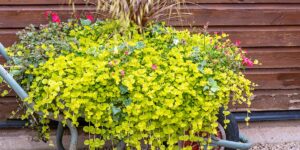
Creeping Jenny’s a Good Houseplant, But It’s Not for Outdoors
Creeping jenny, also known as Lysimachia nummularia, is a fast-growing, low-maintenance plant that thrives both indoors and out.
Indoors, creeping jenny makes a great easy-care houseplant where its cheery rounded leaves and chartreuse- to golden-flowers add a pop of bright color alongside all your other green houseplants.
However, creeping jenny grows a little too well outdoors, especially in the Midwest and Northeast, where it is considered invasive. Though it’s native to Europe and Asia, the plant has naturalized in many areas, including along roadsides and ditches, and in meadows, marshes, and along shorelines.
In some states, such as Massachusetts, Virginia, and Indiana, creeping jenny should not be planted because it forms dense mats and outcompetes native plants, especially in wetland areas.
Outdoors, in places where invasive spread is not a concern (In the South and the Southwest, mostly), it can be grown as a ground cover. However, experts tend to recommend against planting it in landscape beds or along lawns because of its aggressive nature.
The simplest solution is to plant creeping jenny in containers, where it will tumble nicely out of window boxes and pots for that “spiller” effect in mixed plantings. But be sure to prevent the stems from touching the ground. They will root and spread.
Why Trust Us?
I’m a garden writer with more than 15 years of experience growing houseplants, herbs and edibles, and landscape plantings. My houseplant collection includes more than 60+ plants, while my expansive garden includes new annuals, perennials and shrubs that I trial for performance and reliability. I prefer to grow creeping jenny as an indoor plant only to prevent it from becoming too aggressive outdoors.
Creeping Jenny Basic Info:
- Common Name: Creeping jenny, lysimachia, moneywort
- Botanical Name: Lysimachia nummularia
- Plant Family: Primulacea
- Type of Plant: Perennial
- USDA Hardiness Zones: 3 to 9
- Native Origin: Europe, Asia
- Sun Exposure: Full sun to part shade
- Mature Size: 4 inches high to 2 feet wide
- Toxic to pets: No
How to Care for Creeping Jenny
Creeping jenny makes an easy-to-grow houseplant. Outdoors, it’s also low-maintenance but should not be planted in states where it is considered invasive.
Light
Outdoors, creeping jenny prefers full sun but does fine in part sun areas, too. If grown indoors, give it direct sunlight or use a grow light to keep its coloring bright.
Soil
Creeping jenny does well in any well-draining potting soil. In the garden it tolerates all soil types including wet and rocky soils.
Water
Creeping jenny likes consistent moisture. Keep the houseplant slightly moist, or use a self-watering pot.
Fertilizer
Creeping jenny needs little to no fertilizer to thrive. If grown as a houseplant, you can fertilize occasionally with a water soluble general purpose fertilizer at one-quarter to one-half the label recommendation.
Propagating Creeping Jenny
The easiest method for making more of these plants is to take a stem cutting. Snip off a few inches, remove the lower leaves, and place it in a water in a brightly-lit spot (but not in direct sunlight). Change the water every week. Roots should appear in about two weeks, when you can pot up the cuttings in regular potting mix.
Common Problems with Creeping Jenny
Creeping jenny is rarely bothered by insects or pests. If it becomes gangly indoors, you can trim it back and give it more light to improve its growth.
Types of Creeping Jenny
Golden types generally are considered less aggressive, and you’ll typically find ‘Aurea’ and ‘Goldilocks’ to be the most readily available cultivars. Both have bright gold to yellow foliage on alternate sides of the stems. Tiny yellow flowers occasionally appear, but the real thrill is the bright foliage.
Alternatives to Creeping Jenny
If you love the look of this plant but live where it is considered invasive or just don’t want to have to keep a wary eye on it escaping planting beds, consider these better-behaved, low-growing plant alternatives:
- Foamflower (Tiarella cordifolia): Masses of “foamy-looking flowers appear in spring
- Heuchera (Heuchera): Colorful foliage that ranges from lime green to dark burgundy
- Creeping Thyme (Thymus serpyllum): Small leaves covered in pollinator-friendly flowers in spring and early summer
- Mecardonia (Mecardonia): Tiny leaves covered in yellow flowers all summer, especially on the hybrid cultivar ‘GoldDust’






